[English] 日本語
 Yorodumi
Yorodumi- PDB-3bvh: Crystal Structure of Recombinant gammaD364A Fibrinogen Fragment D... -
+ Open data
Open data
- Basic information
Basic information
| Entry | Database: PDB / ID: 3bvh | |||||||||
|---|---|---|---|---|---|---|---|---|---|---|
| Title | Crystal Structure of Recombinant gammaD364A Fibrinogen Fragment D with the Peptide Ligand Gly-Pro-Arg-Pro-Amide | |||||||||
 Components Components |
| |||||||||
 Keywords Keywords |  BLOOD CLOTTING / BLOOD CLOTTING /  Blood coagulation / Disease mutation / Blood coagulation / Disease mutation /  Glycoprotein / Glycoprotein /  Phosphoprotein / Phosphoprotein /  Secreted / Secreted /  Pyrrolidone carboxylic acid / Pyrrolidone carboxylic acid /  Sulfation Sulfation | |||||||||
| Function / homology |  Function and homology information Function and homology informationplatelet maturation /  blood coagulation, common pathway / induction of bacterial agglutination / blood coagulation, common pathway / induction of bacterial agglutination /  fibrinogen complex / Regulation of TLR by endogenous ligand / fibrinogen complex / Regulation of TLR by endogenous ligand /  blood coagulation, fibrin clot formation / blood coagulation, fibrin clot formation /  platelet alpha granule / cellular response to leptin stimulus / cellular response to interleukin-6 / MyD88 deficiency (TLR2/4) ...platelet maturation / platelet alpha granule / cellular response to leptin stimulus / cellular response to interleukin-6 / MyD88 deficiency (TLR2/4) ...platelet maturation /  blood coagulation, common pathway / induction of bacterial agglutination / blood coagulation, common pathway / induction of bacterial agglutination /  fibrinogen complex / Regulation of TLR by endogenous ligand / fibrinogen complex / Regulation of TLR by endogenous ligand /  blood coagulation, fibrin clot formation / blood coagulation, fibrin clot formation /  platelet alpha granule / cellular response to leptin stimulus / cellular response to interleukin-6 / MyD88 deficiency (TLR2/4) / positive regulation of heterotypic cell-cell adhesion / IRAK4 deficiency (TLR2/4) / MyD88:MAL(TIRAP) cascade initiated on plasma membrane / extracellular matrix structural constituent / plasminogen activation / p130Cas linkage to MAPK signaling for integrins / positive regulation of exocytosis / positive regulation of peptide hormone secretion / GRB2:SOS provides linkage to MAPK signaling for Integrins / platelet alpha granule / cellular response to leptin stimulus / cellular response to interleukin-6 / MyD88 deficiency (TLR2/4) / positive regulation of heterotypic cell-cell adhesion / IRAK4 deficiency (TLR2/4) / MyD88:MAL(TIRAP) cascade initiated on plasma membrane / extracellular matrix structural constituent / plasminogen activation / p130Cas linkage to MAPK signaling for integrins / positive regulation of exocytosis / positive regulation of peptide hormone secretion / GRB2:SOS provides linkage to MAPK signaling for Integrins /  protein secretion / protein polymerization / Integrin cell surface interactions / cellular response to interleukin-1 / negative regulation of endothelial cell apoptotic process / Common Pathway of Fibrin Clot Formation / positive regulation of substrate adhesion-dependent cell spreading / negative regulation of extrinsic apoptotic signaling pathway via death domain receptors / positive regulation of vasoconstriction / protein secretion / protein polymerization / Integrin cell surface interactions / cellular response to interleukin-1 / negative regulation of endothelial cell apoptotic process / Common Pathway of Fibrin Clot Formation / positive regulation of substrate adhesion-dependent cell spreading / negative regulation of extrinsic apoptotic signaling pathway via death domain receptors / positive regulation of vasoconstriction /  fibrinolysis / fibrinolysis /  cell adhesion molecule binding / Integrin signaling / cell-matrix adhesion / platelet alpha granule lumen / positive regulation of protein secretion / cell adhesion molecule binding / Integrin signaling / cell-matrix adhesion / platelet alpha granule lumen / positive regulation of protein secretion /  Post-translational protein phosphorylation / Signaling by high-kinase activity BRAF mutants / MAP2K and MAPK activation / Post-translational protein phosphorylation / Signaling by high-kinase activity BRAF mutants / MAP2K and MAPK activation /  platelet aggregation / response to calcium ion / Signaling by RAF1 mutants / Signaling by moderate kinase activity BRAF mutants / Paradoxical activation of RAF signaling by kinase inactive BRAF / Signaling downstream of RAS mutants / Regulation of Insulin-like Growth Factor (IGF) transport and uptake by Insulin-like Growth Factor Binding Proteins (IGFBPs) / platelet aggregation / response to calcium ion / Signaling by RAF1 mutants / Signaling by moderate kinase activity BRAF mutants / Paradoxical activation of RAF signaling by kinase inactive BRAF / Signaling downstream of RAS mutants / Regulation of Insulin-like Growth Factor (IGF) transport and uptake by Insulin-like Growth Factor Binding Proteins (IGFBPs) /  extracellular vesicle / Signaling by BRAF and RAF1 fusions / Platelet degranulation / extracellular vesicle / Signaling by BRAF and RAF1 fusions / Platelet degranulation /  cell cortex / ER-Phagosome pathway / protein-folding chaperone binding / protein-containing complex assembly / collagen-containing extracellular matrix / blood microparticle / cell cortex / ER-Phagosome pathway / protein-folding chaperone binding / protein-containing complex assembly / collagen-containing extracellular matrix / blood microparticle /  adaptive immune response / positive regulation of ERK1 and ERK2 cascade / Amyloid fiber formation / external side of plasma membrane / adaptive immune response / positive regulation of ERK1 and ERK2 cascade / Amyloid fiber formation / external side of plasma membrane /  endoplasmic reticulum lumen / endoplasmic reticulum lumen /  signaling receptor binding / signaling receptor binding /  innate immune response / innate immune response /  synapse / structural molecule activity / synapse / structural molecule activity /  cell surface / cell surface /  endoplasmic reticulum / endoplasmic reticulum /  extracellular space / extracellular exosome / extracellular region / identical protein binding / extracellular space / extracellular exosome / extracellular region / identical protein binding /  metal ion binding / metal ion binding /  plasma membrane plasma membraneSimilarity search - Function | |||||||||
| Biological species |   Homo sapiens (human) Homo sapiens (human)synthetic construct (others) | |||||||||
| Method |  X-RAY DIFFRACTION / X-RAY DIFFRACTION /  SYNCHROTRON / SYNCHROTRON /  MOLECULAR REPLACEMENT / Resolution: 2.6 Å MOLECULAR REPLACEMENT / Resolution: 2.6 Å | |||||||||
 Authors Authors | Bowley, S.R. / Merenbloom, B.K. / Betts, L. / Okumura, N. / Heroux, A. / Gorkun, O.V. / Lord, S.T. | |||||||||
 Citation Citation |  Journal: Biochemistry / Year: 2008 Journal: Biochemistry / Year: 2008Title: Polymerization-defective fibrinogen variant gammaD364A binds knob "A" peptide mimic. Authors: Bowley, S.R. / Merenbloom, B.K. / Okumura, N. / Betts, L. / Heroux, A. / Gorkun, O.V. / Lord, S.T. | |||||||||
| History |
|
- Structure visualization
Structure visualization
| Structure viewer | Molecule:  Molmil Molmil Jmol/JSmol Jmol/JSmol |
|---|
- Downloads & links
Downloads & links
- Download
Download
| PDBx/mmCIF format |  3bvh.cif.gz 3bvh.cif.gz | 284.8 KB | Display |  PDBx/mmCIF format PDBx/mmCIF format |
|---|---|---|---|---|
| PDB format |  pdb3bvh.ent.gz pdb3bvh.ent.gz | 228.6 KB | Display |  PDB format PDB format |
| PDBx/mmJSON format |  3bvh.json.gz 3bvh.json.gz | Tree view |  PDBx/mmJSON format PDBx/mmJSON format | |
| Others |  Other downloads Other downloads |
-Validation report
| Arichive directory |  https://data.pdbj.org/pub/pdb/validation_reports/bv/3bvh https://data.pdbj.org/pub/pdb/validation_reports/bv/3bvh ftp://data.pdbj.org/pub/pdb/validation_reports/bv/3bvh ftp://data.pdbj.org/pub/pdb/validation_reports/bv/3bvh | HTTPS FTP |
|---|
-Related structure data
| Related structure data |  1lt9S S: Starting model for refinement |
|---|---|
| Similar structure data |
- Links
Links
- Assembly
Assembly
| Deposited unit | 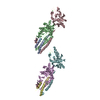
| ||||||||
|---|---|---|---|---|---|---|---|---|---|
| 1 | 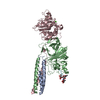
| ||||||||
| 2 | 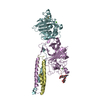
| ||||||||
| Unit cell |
|
- Components
Components
-Protein , 3 types, 6 molecules ADBECF
| #1: Protein |  Mass: 7276.447 Da / Num. of mol.: 2 / Fragment: residues 148-209 Source method: isolated from a genetically manipulated source Source: (gene. exp.)   Homo sapiens (human) / Gene: FGA / Plasmid: pMLP / Production host: Homo sapiens (human) / Gene: FGA / Plasmid: pMLP / Production host:   Cricetulus griseus (Chinese hamster) / References: UniProt: P02671 Cricetulus griseus (Chinese hamster) / References: UniProt: P02671#2: Protein |  Mass: 34171.359 Da / Num. of mol.: 2 / Fragment: residues 191-488 Source method: isolated from a genetically manipulated source Source: (gene. exp.)   Homo sapiens (human) / Gene: FGB / Plasmid: pMLP / Production host: Homo sapiens (human) / Gene: FGB / Plasmid: pMLP / Production host:   Cricetulus griseus (Chinese hamster) / References: UniProt: P02675 Cricetulus griseus (Chinese hamster) / References: UniProt: P02675#3: Protein |  Mass: 33293.949 Da / Num. of mol.: 2 / Fragment: residues 128-420 / Mutation: D390A Source method: isolated from a genetically manipulated source Source: (gene. exp.)   Homo sapiens (human) / Gene: FGG / Plasmid: pMLP / Production host: Homo sapiens (human) / Gene: FGG / Plasmid: pMLP / Production host:   Cricetulus griseus (Chinese hamster) / References: UniProt: P02679 Cricetulus griseus (Chinese hamster) / References: UniProt: P02679 |
|---|
-Protein/peptide / Sugars , 2 types, 6 molecules GIHJ
| #4: Protein/peptide | Mass: 426.490 Da / Num. of mol.: 4 / Source method: obtained synthetically / Details: synthetic peptide / Source: (synth.) synthetic construct (others) #5: Polysaccharide |  / Mass: 570.542 Da / Num. of mol.: 2 / Mass: 570.542 Da / Num. of mol.: 2Source method: isolated from a genetically manipulated source |
|---|
-Non-polymers , 2 types, 450 molecules 


| #6: Chemical | ChemComp-CA / #7: Water | ChemComp-HOH / |  Water Water |
|---|
-Experimental details
-Experiment
| Experiment | Method:  X-RAY DIFFRACTION / Number of used crystals: 1 X-RAY DIFFRACTION / Number of used crystals: 1 |
|---|
- Sample preparation
Sample preparation
| Crystal | Density Matthews: 3.18 Å3/Da / Density % sol: 61.33 % |
|---|---|
Crystal grow | Temperature: 277 K / Method: vapor diffusion, sitting drop / pH: 8.5 Details: 9 % PEG 3350, 50 mM Tris-HCl pH 8.5, 2 mM sodium azide, 12.5 mM sodium chloride, VAPOR DIFFUSION, SITTING DROP, temperature 277K |
-Data collection
| Diffraction | Mean temperature: 100 K |
|---|---|
| Diffraction source | Source:  SYNCHROTRON / Site: SYNCHROTRON / Site:  NSLS NSLS  / Beamline: X29A / Wavelength: 1.1 Å / Beamline: X29A / Wavelength: 1.1 Å |
| Detector | Type: ADSC QUANTUM 315 / Detector: CCD / Date: Apr 22, 2005 |
| Radiation | Monochromator: Si(111) / Protocol: SINGLE WAVELENGTH / Monochromatic (M) / Laue (L): M / Scattering type: x-ray |
| Radiation wavelength | Wavelength : 1.1 Å / Relative weight: 1 : 1.1 Å / Relative weight: 1 |
| Reflection | Resolution: 2.6→50 Å / Num. obs: 66878 / % possible obs: 82.4 % / Observed criterion σ(F): 0 / Observed criterion σ(I): 0 / Redundancy: 3.8 % / Biso Wilson estimate: 35.2 Å2 / Net I/σ(I): 13.7 |
| Reflection shell | Resolution: 2.65→2.79 Å / Redundancy: 3.3 % / Mean I/σ(I) obs: 4.8 / Num. unique all: 66878 / Rsym value: 0.287 / % possible all: 94.2 |
- Processing
Processing
| Software |
| |||||||||||||||||||||||||
|---|---|---|---|---|---|---|---|---|---|---|---|---|---|---|---|---|---|---|---|---|---|---|---|---|---|---|
| Refinement | Method to determine structure : :  MOLECULAR REPLACEMENT MOLECULAR REPLACEMENTStarting model: PDB ENTRY 1LT9 Resolution: 2.6→50 Å / σ(F): 0
| |||||||||||||||||||||||||
| Displacement parameters | Biso mean: 37.3 Å2
| |||||||||||||||||||||||||
| Refinement step | Cycle: LAST / Resolution: 2.6→50 Å
| |||||||||||||||||||||||||
| Refine LS restraints |
| |||||||||||||||||||||||||
| LS refinement shell | Resolution: 2.59→2.63 Å
|
 Movie
Movie Controller
Controller



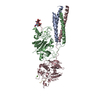
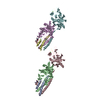







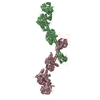
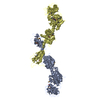
 PDBj
PDBj











